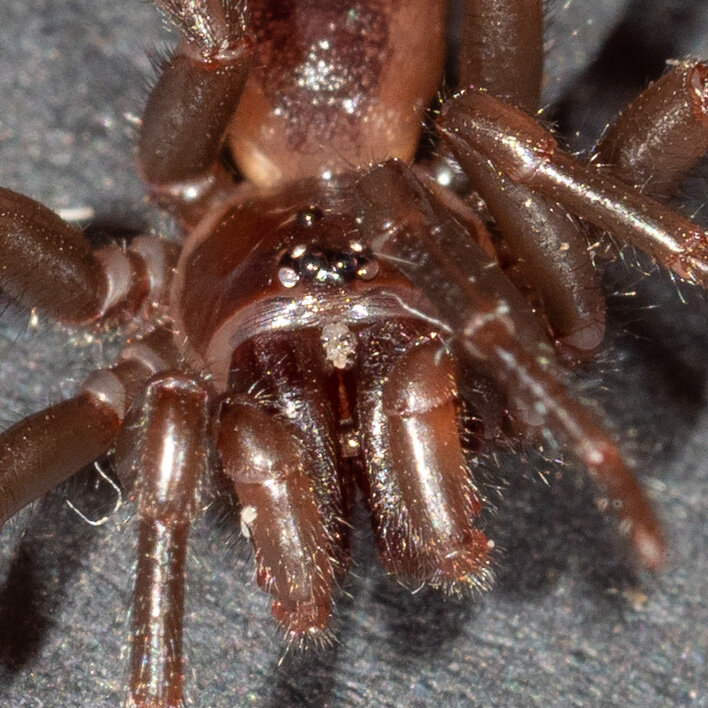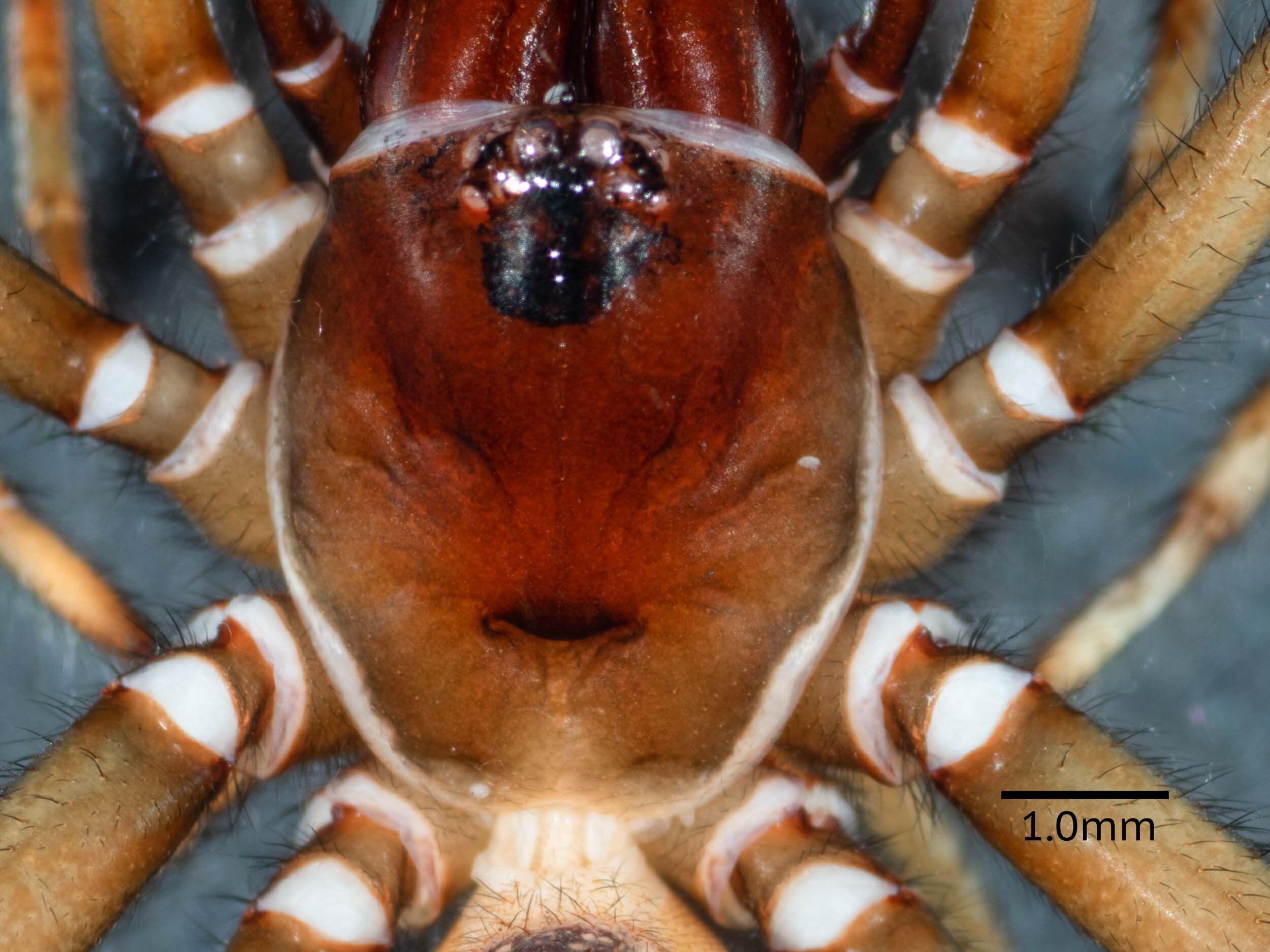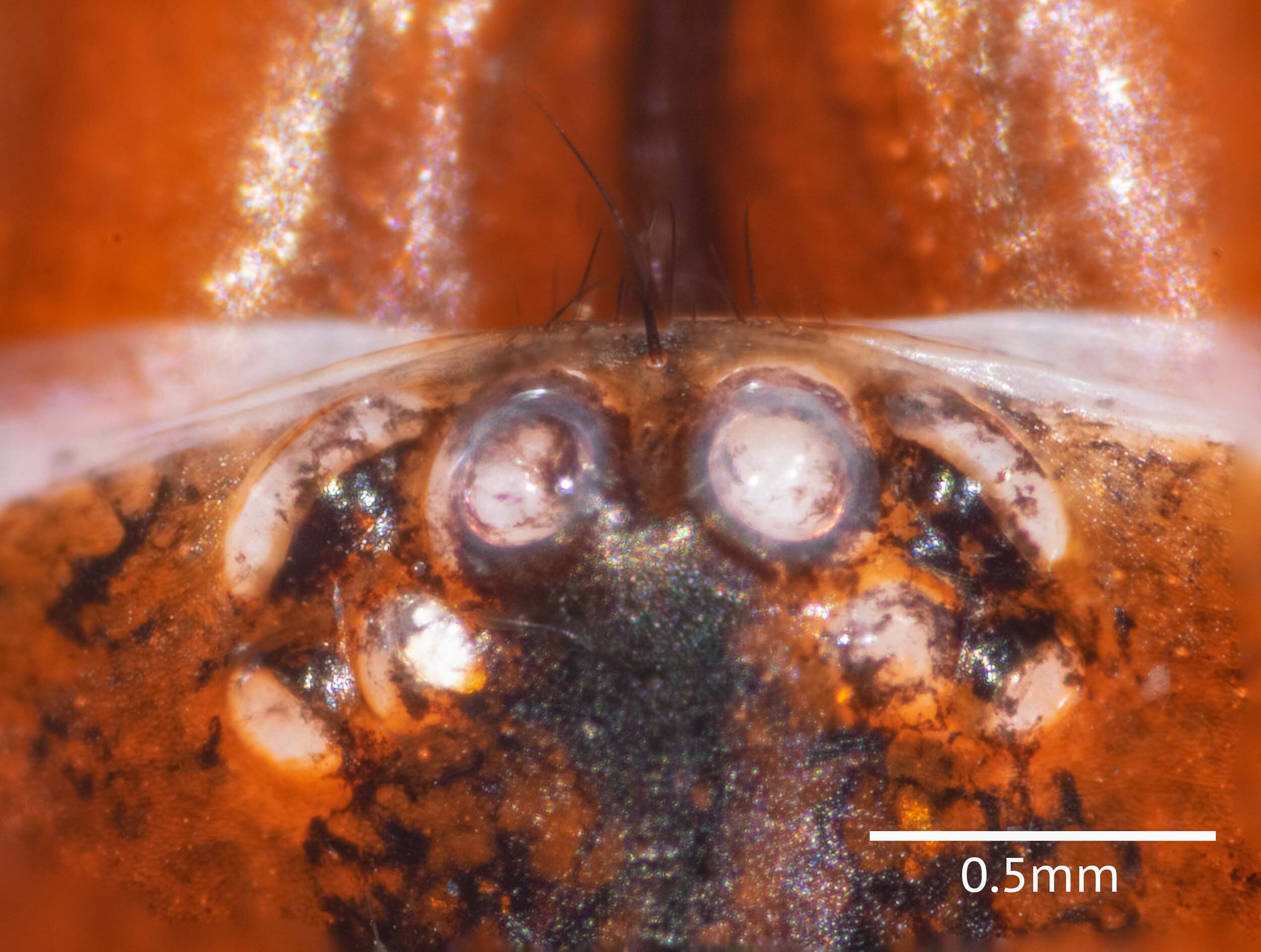A new atracid species

Workbook
2021 collection:
This small mygalomorph spider appears to be a new species and perhaps even a new genus.
This species shares many features with members of the Atracidae family, but does not fit neatly into any of the three existing genera: Atrax, Hadronyche or Illawarra. We have worked through the family descriptions for the other ten families currently listed in the Australian Faunal Directory and have excluded them all based on morphological differences in key diagnostic features (detailed workings here).
The four male spiders we collected are identical. We now recognise that the two male spiders sighted in June 2018, at the same site, were also this species.
Diagnosis. In general appearance, this looks like a small atracid. However, the species differs from currently described species. Notably:
differs from Atracidae – only a single row of cheliceral teeth; labium is short and elliptical with few cuspules.
differs from Atrax – much smaller; tibia II lacks apophysis; caput higher and frontally wider; shorter apical segment of posterior lateral spinneret; femora I and II lack dorsal spines; palpal patella much wider than femur.
differs from Illawarra – carapace more strongly raised; labium convex anteriorly; tarsi with few spines.
differs from Hadronyche – lacks central row of cheliceral teeth; labium elliptical rather than sub quadrate. In addition:
differs from infensa group – much smaller; labium shorter; shorter apical segment of posterior lateral spinneret.
differs from adelaidensis group – femora I and II lack dorsal spines.
does share several characteristics with the spiders in the lamingtonensis group, including: small size; labium shape and with relatively few cuspules; short apical segments of posterior lateral spinnerets; boat-shaped tarsus IV.
Locality: Wonboyn, New South Wales. Four males collected 22nd May, 2020 by Paul Whitington and Kerri-Lee Harris. The collection site is a largely intact dry sclerophyll forest, although the spiders were actually discovered adjacent to a building on the property. It was a wet night and the spiders were walking across the ground and climbing the wall (images below).
Morphological description
All measurements in the description below are in millimetres. All specimens are mature males. Measurement points as described by Gray (2010). All measurements involved a single specimen, designated spider #1. The images below include various specimens. Each image includes the spider # and state: live, recently dead or preserved in 100% ethanol.
Abbreviations: ALE - anterior lateral eye; AME - anterior medial eye; PLE - posterior lateral eye; PME - posterior medial eye; CL - carapace length; CW - carapace width; CH - carapace height; CFW - clypeal frontal width; CUSP - labium cuspule number; LL - labium length; LW - labium width; PLSAPL - posterior lateral spinneret apical segment length; PLSAPW - posterior lateral spinneret apical segment width; SL - sternum length; SW - sternum width; STC - superior tarsal claws
Colour: (live) carapace and legs mid-brown; chelicerae darker brown; abdomen ventrally and laterally pale pink-brown; abdomen dorsally dark brown-purple, lacking pattern.
Carapace: carapace length 4.3, width 3.55, frontal width 3.0, height 2.2; caput is strongly raised (CH/CW 0.64) and broad frontally (CFW/CL 0.70); caput spans the anterior edge of the carapace; fovea a transverse groove; clypeus with cluster of short bristles centrally, and one long bristle between AME; pleura widest in line with fovea, and coxa of leg III.
Eyes: in rectangular group on low tubercle, in two rows of four; eye group length 0.5., width 1.1-1.3; Eye diameters: AME 0.28; ALE 0.34: PME 0.19 PLE 0.19.
Chelicerae: robust cheliceral paturon; cheliceral groove is flattened, not depressed; single row of 8-9 cheliceral teeth along promargin (medial); no teeth along retromargin; varying number of basal granules.
Maxillae: maxillae longer than wide; strong coniform lobe anteromedially; numerous cuspules (40-45) in medioventral region, basally.
Maxillae (ventral), with lobes arrowed [spider #1 in ethanol]
Labium: elliptical, wider than long (LL/LW 0.68); sparse cluster of capsules (c. 30) over anteroventral two-thirds.
Labium and labiosternal sigilla (ventral) [spider #1 in ethanol]
Sternum: ovoid, longer (2.7) than wide as wide (2.3); posterior sigilla narrowly ovoid; two anterior pairs smaller.
Sternum and sternal sigillae (ventral) [spider #1 in ethanol]
Spinnerets: four spinnerets; PMS separated by more than width of basal segment; PLS with short conical terminal segment; PLS segments, lengths: total 1.2; basal 0.58; middle 0.26; apical 0.26; PLSAPW 0.26.
Legs: tibia I with 5 ventral spines; metatarsus I unmodified; with 8-9 ventral spines; tibia II unmodified; with three ventral spines (small pro distal, large mid ventral, medium proximal).
Metatarsus II weakly sinuous; ventrally concave proximally; with slight apophyseal swelling.
Leg tarsi: tarsi III and IV are longer and wider than tarsi I and II; tarsus IV is thickest in the distal mid section;
Scopulae: present on ventral surface of all tarsi; tarsus III and IV have wide band of thick, bent scopular hairs; scopula extends onto metatarsus of leg IV; scopulae weaker on tarsi I and II, and flanked by spines.
tarsal measurements (in millimetres) [spider #1 in ethanol]
Tarsal claws: each leg has three tarsal claws; STC with a single row of 8 – 9 teeth varying in size; tooth row is sigmoidal, extending from the lateral edge (proximally) to medial edge (distally); tooth row discontinuous or absent in most basal region of claw.
Trichobothria: filiform with weakly delineated basal cups (‘bothria’); tibia with dorsal double row, basally; metatarsus with dorsal single row; tarsus with dorsal, zig-zag row.
Male palps: femur thickened distally; patella wider than femur; tibia without apophysis; cymbium bilobed; subtegulum smaller than tegulum, the two separated by a deep groove; embolus twisted distally.
References
Bond JE, Hendrixson BE, Hamilton CA, Hedin M. 2012. A reconsideration of the classification of the spider infra- order Mygalomorphae (Arachnida: Araneae) based on three nuclear genes and morphology. PLoS One 7: e38753
Felix, R.F. 2011. Biology of Spiders (3rd Edition). Oxford University Press, New York.
Gray. M. 2010. A revision of Australian funnel-web spiders. Records of the Australian Museum, 62: 285=392.
Main, B.Y. & Mascord, R. 1971. A new genus of diplurid spider (Araneae: Mygalomorphae) from New South Wales [online]. Journal of the Entomological Society of Australia (N.S.W.), Vol. 6 (1969): 24-30
Main, B. Y. 1985. Further studies on the systematics of the ctenizid trapdoor spiders: a review of the Australian genera (Araneae : Mygalomorphae : Ctenizidae). Australian Journal of Zoology, Supplementary Series. 108, 1-84.
Opatova, V., Hamilton, C.A., Hedin, M., Montes de Oca, L., Kral, J. & Bond, J.E. 2019. Phylogenetic systematics and evolution of the spider infraorder Mygalomorphae using genomic scale data. Systematic Biology, 1: 1-37
Raven, R.J. 2000. A new species of funnel web spider (Hadronyche : Hexathelidae : Mygalomorphae) from north Queensland. Memoirs of the Queensland Museum, 46, 225-230.
Rix, M.G., Raven, R.J., Main, B.Y., Harrison, S.E., Austin, A.D., Cooper, S.J.B. & Harvey, M.S. 2017. The Australasian spiny trapdoor spiders of the family Idiopidae (Mygalomorphae ; Arbanitinae): a relimitation and revision at the generic level. Invertebrate Systematics, 31, 566-634.
This is a workbook page … a part of our website where we record the observations and references used in making species identifications. The notes will not necessarily be complete. They are a record for our own use.




































![tarsal measurements (in millimetres) [spider #1 in ethanol]](https://images.squarespace-cdn.com/content/v1/58ec80a8d2b857fe42e4f603/1591424424272-PFYIJ9CIDI6CJLOG7SAC/table+of+tarsal+dimensions.jpg)




























